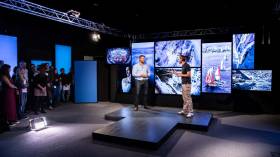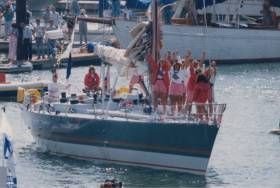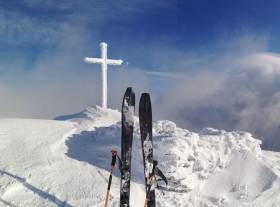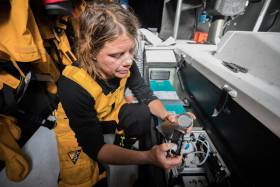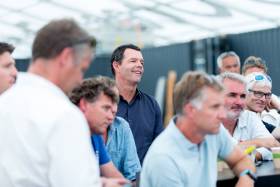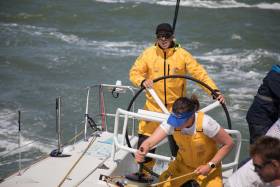Displaying items by tag: VOR
“This is a big moment for The Ocean Race,” said managing director Johan Salén at this week’s official launch of the event previously known as the Volvo Ocean Race.
“We are excited to be moving forward with a new identity that reflects the best of our heritage – human ambition, technology, competition and teamwork – while adding in new elements, like our core focus on sustainability.”
Formerly known as the Whitbread Round the World Race (1973 to 1997) and the Volvo Ocean Race (2001 to 2018), The Ocean Race was taken over by new owners Atlant Ocean Racing Spain last year, but retains previous owner Volvo as a premier race partner.
The next edition of The Ocean Race will start in 2021 from Alicante, Spain with two classes of boats racing: the high-tech, foiling IMOCA 60s and the one-design Volvo Ocean 65 fleet that provided the closest race in the history of the event in the last edition.
“Opening up The Ocean Race to the IMOCA class isn’t just exciting for the sailors. It puts us back at the forefront of technology and gets the entire marine sector – from designers and engineers, to boatbuilders and sailmakers – involved in the race again,” said executive director Richard Mason.
“There are nine new IMOCA 60s in build across the world and we know several of them are being prepared as projects for our race. And on the other side, we already have six of the eight VO65s that are essentially spoken for by campaigns planning to be on the start line in 2021.”
Two Volvo Ocean 65 campaigns were announced on Thursday.
Paulo Mirpuri, chair of the Mirpuri Foundation and a founding partner of Turn the Tide on Plastic in the last race, announced he would have at least one team competing in The Ocean Race.
“Our intention is to build a campaign in the VO65 boat – the one-design class that produced such thrillingly close racing last time out – to take our sustainability message around the globe.”
Mirpuri added in a video link from Portugal that he was intrigued by the technology challenge posed by the IMOCA 60 and was considering a second entry in that class.
Bianca Cook, who raced on board Turn the Tide on Plastic in the 2017-18 event, announced she would be spearheading a New Zealand-flagged team.
And Tony Rae (Trae), a veteran of six editions of the race, twice as a winner, as well as seven America’s Cup teams, is on board to manage the campaign.
“After the race finished in The Hague, I was ready to go again and since then I’ve been working with Trae to put together a team for the next Ocean Race,” Cook said.
“We have a deep pool of New Zealand sailors to draw from as we put together the crew – I can’t mention any names just yet – but watch this space.”
Further team announcements are likely over the coming weeks and months, despite the start being two-and-a-half years away.
Xabi Fernández and Paul Meilhat are among those working to get teams together for the gruelling round-the-world ocean yachting challenge.
The 2021-22 edition of The Ocean Race will feature up to nine stopover ports, with the host city procurement process now under way.
“It’s an exciting time,” said Antoine Mermod, president of IMOCA. “For a few months we’ve been working together with The Ocean Race to organise the best event we can. What The Ocean Race is building is really something that will change the offshore sailing world in the future.”
Tracy Edwards Documentary Set For Special Q&A Screening At Dublin’s IFI
The Irish Film Institute in Dublin joins the list of locations for a special screening of Alex Holmes’ Tracy Edwards documentary Maiden on Thursday 7 March.
As previously reported on Afloat.ie, Cork’s Gate Cinemas will also host the preview followed by a satellite link Q&A with Tracy Edwards and some special guests.
Edwards made history as the skipper of the first ever all-female crew to enter the Whitbread Round the World Race, which became the Volvo Ocean Race and is now simply The Ocean Race after its recent change of ownership.
Maiden opens at the IFI on Friday 8 March. Tickets are available for the special preview from 6pm on Thursday 7 March from the IFI box office.
Volvo Ocean Race Veteran Damian Foxall Descends Ireland’s Highest Mountain On Skis
Kerry’s own Volvo Ocean Race winner Damian Foxall has made the news for a very different achievement — descending Ireland’s highest mountain on skis.
The veteran round-the-world sailor made an early start on Saturday morning (2 February) for the ski climb to the peak of Carrauntoohil before the 400-metre descent to the Devil’s Ladder, making the most of the recent heavy snowfall.
As RTÉ News reports, the weekend’s feat marked Foxall’s first attempt to ski the slope known locally as the Shoulder of Corrán.
“The feeling was unreal, exhilarating, a once-in-a-decade experience,” he said.
But the weekend didn’t end there for Foxall as he joined his friend and fellow sustainability manager Lucy Hunt, from the Sea Synergy Marine Awareness and Activity Centre in Waterville, for an adventurous Sunday on skis in the mountains.
The pair went from Curve Gully to Carrauntoohil, then followed the ridge line to four more peaks of the McGillycuddy Reeks “in Alpine conditions”, according to Foxall’s Facebook page.
Tracy Edwards Documentary To Have ‘Maiden’ Screening In Cork Next Month
Cork’s Gate Cinemas will stage a special screening of the new Tracy Edwards documentary Maiden, followed by a satellite link Q&A with Edwards herself, on Thursday 7 March.
Edwards was a 24-year-old cook on charter boats when in 1989 she became the skipper of the first ever all-female crew to enter the Whitbread Round the World Race, the precursor to the Volvo Ocean Race.
Maiden charts Edwards’ struggle against the odds — facing chauvinism in the yachting community, and rejection from sponsors — to put a team on the water.
Sailing a second-hand yacht financed by remortgaging her home, Edwards and her crew showed the world that women sailors were capable of doing everything their male counterparts could.
And their legacy can be seen more recently both in the all-woman Team SCA in the 2014-15 VOR, and the most recent edition that encouraged mixed crews. Indeed, Olympians Carolijn Brouwer and Marie Riou were part of the crew on the race-winning Dongfeng Race Team.
Maiden opens on Friday 8 March but tickets go on sale today (Friday 1 February) for the special preview screening in Cork the night before. Tickets go on sale today with details to follow.
‘No Compromise’ On Sustainability In Volvo Ocean Race Says Damian Foxall
#VOR - Kerry sailor and Volvo Ocean Race veteran Damian Foxall had a very different role in the most recent edition of the round-the-world yacht race.
As sustainability manager for Vestas 11th Hour Racing, Foxall was responsible for guiding the team towards the title of the race’s ‘most sustainable’. His secret? “No compromise.”
Foxall spoke to Sport Sustainability Journal upon the publication of his team’s comprehensive sustainability report, which outlines various initiatives from grants for local projects along the route, to carbon reduction and offsetting on the yacht and among the crew.
The latter included the likes of reduced plastic packaging for official race clothing supplied by Musto, to ‘meatless Mondays’ below deck.
“The further we got into the race … we found sustainability brought a depth and strength to our team,” Foxall says.
Sport Sustainability Journal has much more on the story HERE.
West Of Ireland Among Only Three Ocean Sites Free Of Microplastic In Volvo Ocean Race Data
#Microplastic - The West of Ireland is one of only three sites sampled out of 75 during the Volvo Ocean Race with no trace of microplastic particles.
South of Australia and east of Argentina were the other sites found clear of microplastic in findings that give a clear mandate for positive and decisive action from national governments, international organisations, business and individuals to stop plastic polluting our seas.
The most recent data collected, before the race finale in The Hague, by scientific devices on board Team AkzoNobel and Turn the Tide on Plastic found particularly high levels of microplastics — 224 particles per cubic metre — in Skagerrak, a 150-mile strait that runs between Norway, Sweden and Denmark where the outflow from the Baltic Sea meets the Atlantic Ocean.
The highest levels of microplastic — 349 particles per cubic metre — were found in a sample taken in the South China Sea that feeds into the Kuroshio Current and the North Pacific Gyre.
The second highest, at 307 particles per cubic metre, came close from the point where the Mediterranean Sea and Atlantic Ocean meet at the Strait of Gibraltar.
Even close to Point Nemo, the furthest place from land on Earth, where the nearest humans are on the International Space Station, between nine and 26 particles of microplastic per cubic metre were recorded.
The seawater samples were collected during the course of the 45,000-nautical-mile, eight-month race which passed six continents and 12 landmark host cities. The race began in Alicante last October, finishing in The Hague in June.
Anne-Cecile Turner, sustainability programme leader for the Volvo Ocean Race, said: “We have used a sporting event to collect groundbreaking scientific data to provide a global map of microplastics concentrations — even finding them in some of the remotest places on Earth.
“Our ambition is that the data will provide a new benchmark for our understanding of the spread of these ubiquitous particles and offer a template for future scientific methodology.
“With the continuation of the sustainability programme, we will continue our mission to inspire, engage and act as a pioneer, with the aim of restoring ocean health.”
Dr Toste Tanhua of the GEOMAR Institute for Ocean Research Kiel, funded by the Cluster of Excellence Future Ocean, analysed the preliminary microplastics data at their laboratory in Kiel, Germany.
The data has since been uploaded to a National Oceanic and Atmospheric Administration (NOAA) database where scientists are able to access it open source.

Dr Tanhua said the Volvo Ocean Race Science Programme “has contributed enormously to the understanding of microplastic contribution around the world, and has contributed to a global map of CO2 uptake by the oceans. The race has showed that the race yachts and sailors can be excellent science supporters.”
The boats also collect other oceanographic data measurements including temperature, dissolved CO2, salinity and algae content (as chlorophyll a) that gives an indication of levels of ocean health and acidification and supports quantification of the ocean’s uptake of carbon dioxide.
In parallel, 30 scientific drifter buoys deployed during the race are transmitting data that is essential for forecasting of weather and climate changes, in both the short and long term. This is being utilised by the World Meteorological Organisation and UNESCO’s Intergovernmental Oceanographic Commission.
The Volvo Ocean Race Science Programme is funded by Volvo Cars, which is donating €100 from the first 3,000 sales of the new Volvo V90 Cross Country Volvo Ocean Race edition to support the initiative.
Microplastics are often invisible to the naked eye and can take thousands of years to degrade. By collecting information on their levels, the science programme is helping scientists gain insight into the scale of plastic pollution and its impact on marine life.
To build upon the programme’s sustainability achievements, it will be embedded at the heart of the race going forward. And in the run up to the next edition, the programme will continue to organise a range of international Ocean Summits, further expand the education programme and continue to pioneer a scientific programme focussing on ocean plastic.
It will also collaborate with a range of innovative partners, including 11th Hour Racing and UN Environment, to help deliver a lasting legacy and drive real change for a healthy planet.
Since the end of the latest race, the sustainability programme convened a workshop with key global stakeholders from science, academia, the private sector and other institutions, including UN Environment and Mirpuri Foundation, to identify the gaps to fill in order to advance our understanding of these issues and to align our missions.
Fiona Ball, head of responsible business at Sky Ocean Rescue, said: “The data that Turn the Tide on Plastic collected throughout Volvo Ocean Race highlights the critical state of our oceans. By supporting the Turn the Tide on Plastic yacht, Sky Ocean Rescue aims to raise awareness and inspire everyone to make simple, everyday changes to stop our oceans from drowning in plastic. We can all play our part and turn off the plastic tap, now is the time for fundamental change to protect our planet.”
#VOR - The Volvo Ocean Race has announced its partnership agreement with the International Monohull Open Class Association (IMOCA), which provides the exclusivity to use the IMOCA 60 for crewed round the world yacht races.
Last week, during the finish of the Volvo Ocean Race in The Hague, an educational session for interested parties was held around the IMOCA Class Rules.
Sailors from the most recent Volvo Ocean Race and IMOCA events, along with yacht designers currently involved in construction of new IMOCA Class boats such as Guillaume Verdier and Juan Kouyoumdjian, came to The Hague to brainstorm around the changes.
“This is a first step of many in preparing for the next edition of the race in 2021,” said Johan Salen, co-president of the race. “There is an ongoing co-operation process to put in place the elements we need to make the next race a success from a sporting and business point of view.
“This is a complex matter with many perspectives, and we are respectfully welcoming continuous input from all key stakeholders, from World Sailing to individual sailors, teams and partners. We are confident that this is the right way forward.
“Moving the race into foiling monohulls under the IMOCA class will motivate more sailors, teams and the wider marine industry to prepare for the next edition. Partnering with the existing IMOCA infrastructure means the professional offshore sailing calendar becomes more unified and efficient, this helps the sport as a whole and helps to build a sustainable business model for teams and sailors.”
“This agreement provides IMOCA owners and sailors with access to the premiere fully crewed offshore race in the world, which is also a great storytelling platform,” said Antoine Mermod, president of IMOCA.
“As we work together to bring the most important offshore races in the world – short-handed and fully crewed – to the IMOCA class boats, it will allow us to grow the class internationally and offer more value to our stakeholders.”
 Rendering of a possible future design for the race
Rendering of a possible future design for the race
The move to include IMOCA boats has been made in an effort to ensure the race continues at the forefront of yacht design and technology while challenging the best sailors in the world in a fully crewed, offshore environment.
A joint committee is being formed to draft a specific section of the Class Rules for Crewed IMOCA 60, respecting the spirit and intent of the partnership, which includes cost control, security and sporting fairness.
The rule relating to crew numbers on board the IMOCA class in the next race is among the items under consideration, with the goal of retaining an On Board Reporter role.
The latest Volvo Ocean Race concluded this past weekend having seen the closest racing in the 45-year history of the event.
Three teams started the final leg with an opportunity to win the overall race title. With less than 10 miles left in the 45,000 nautical mile, 11-leg race, the outcome was still in doubt until Charles Caudrelier’s Dongfeng Race Team finally slipped ahead of their rivals to secure a thrilling victory off The Hague.
“This change is very exciting,” Caudrelier said after receiving a briefing on the changes. “The Open 60s are just amazing boats. I really enjoy sailing on these boats and I think when people see it, they will enjoy it. If the two best offshore races in the world are going to join the same class, to me it’s good news.”
“I think as a sailor, this is very exciting,” said Bouwe Bekking, a veteran of eight Volvo Ocean and Whitbread Round the World races. “For the younger generation of sailors, they’re all about foiling and surfing and going fast and you have to get the best sailors involved in the race. With the Open 60s, they’ve nailed it, because this is what the sailors want.”
“Of course there are some hurdles to negotiate,” said Torben Grael, Olympic champion and a Volvo Ocean Race winning skipper as well as a vice-president of World Sailing.
“But if we manage to join the two worlds together then it will be positive as it opens the race to many new sailors to join and creates a much bigger calendar of events for the teams racing in Open 60s.”
The partnership means the leading designers in offshore sailing will be engaged in the next edition of the race with the goal of producing the fastest fully-crewed offshore round the world racing monohull in history.
“Yachting is a sport that isn’t only about the crew, but it’s also about the equipment, so combining the two elements is what allows you to say you are at the pinnacle of offshore racing,” said Juan Kouyoumdjian, who has designed three Volvo Ocean Race-winning boats in the past.
“I think it is a very positive step forward. The future will allow for the sailors and designers to push to the next level which will inevitably trickle down to other classes.”
“We’re trying to make a boat for the future that is capable of doing both short-handed and fully-crewed races,” said Guillaume Verdier, among of the busiest of the current IMOCA class and America’s Cup designers. “My opinion is that it is doable with a bit of compromise from both worlds to meet in the middle.”
The partnership with IMOCA will also ensure that the boats will allow for the production of cutting-edge media, as was the case on the current edition of the Volvo Ocean Race.
Live access to the boats while they were racing in some of the most remote oceans of the world, as well as drone footage and media produced by on-board reporters made for ground-breaking coverage that produced record fan engagement.
This remains an important priority for the next race, as does crew diversity. The 2017-18 Volvo Ocean Race featured 23 female sailors as well as 30 sailors under the age of 30. Both were records for the race. This is a trend to be encouraged for the future, race organisers insist.
“The process is just starting,” said Nick Bice, who is leading the project to develop the Open 60 rule for the next race. “We’ve had four of the current IMOCA designers with us to help us understand the issues we’re going to face.
“We’ll forward everyone’s input to the joint committee and get started on developing the rules that will be used for Open 60s to participate in the next race. Our goal is to have this ready to go by the end of the year.”
The future of the VO65 class of boats, used in the last two editions of the race, will be revealed in the coming weeks.
Turn The Tide On Plastic Take Sixth Place Overall In Volvo Ocean Race With Final In-Port Comeback
#VOR - It took until the final in-port race, but Dee Caffari’s Turn the Tide on Plastic moved off the bottom of the overall leaderboard this afternoon (Saturday 30 June) after securing sixth place in the Volvo Ocean Race.
The day started with Sun Hung Kai/Scallywag and Turn the Tide on Plastic with equal points on the overall standings.
The tie-break mechanism is the finishing position in the In-Port Race Series, and there David Witt’s Scallywags held the advantage by a three-point margin.
But if Caffari could level the score or get ahead on the In-Port Series leaderboard, then her team — among them Ireland’s Rio 2016 hero Annalise Murphy — would lift themselves into a sixth place finish overall by winning the tie-break.
A lot of things would need to go right for Caffari in this afternoon’s Brunel In-Port Race in The Hague. And incredibly, it all came to pass.
It didn’t look good early when Turn the Tide on Plastic was penalised for not keeping clear of Team AkzoNobel on a close cross.
But at the next mark rounding, Scallywag hooked onto the mark, and was stopped while the rest of the fleet sailed past.
Eventually they freed themselves from the mark, but by then they were well behind and running out of time to catch up.
The last place result for Scallywag, combined with a hard-fought fourth-place finish for Turn the Tide on Plastic, means Dee Caffari’s team sit in sixth place for the first time in the race.
“We had a good race, we even took a penalty today. But we had very good boat speed, made some good calls, and thankfully there were a couple of boats between us and Scallywag,” an overjoyed Caffari said.
“It’s the best way to finish the campaign for us. We’ll all go away knowing we made some good finishes and and were able to come back. People didn’t know if we could do it, but we have, and it’s just rounded it all off to finish like this.”
That wasn’t the only scoreboard move on Saturday. Hometown hero Bouwe Bekking’s Team Brunel had a perfect start and led the race from beginning to end.
That win, combined with a third place finish on Saturday by Team AkzoNobel, means the two Dutch skippers finished tied for third in the In-Port Race Series, with Team Brunel taking the tie-break for the final podium spot by virtue of a better finishing position in the final race.
“We are really happy of course, not just for ourselves but also for the Dutch public. To have us winning and team AkzoNoble come in third you can’t ask for much more than that,” Bekking said.
“It’s nice to finish racing here where I started my career sailing offshore. Very happy to finish it this way, and thankful for all the support here.”
For Bekking, the race victory puts a stamp on a career that has included eight editions of the Volvo Ocean Race. It was a fantastic day for the Dutch sailing hero to take a win.
The Brunel In-Port Race marks the last competition in this edition of the Volvo Ocean Race. Announcements concerning the next race, currently scheduled to begin in 2021, can be expected shortly.
Volvo Ocean Race In-Port Race Series Leaderboard - Final
- MAPFRE – 64 points
- Dongfeng Race Team – 56 points
- Team Brunel – 50 points
- Team AkzoNobel – 50 points
- Vestas 11th Hour Racing – 35 points
- Turn the Tide on Plastic – 25 points
- Sun Hung Kai/Scallywag – 25 points
Volvo Ocean Race Overall Points Leaderboard - Final
- Dongfeng Race Team – 73 points
- MAPFRE – 70 points
- Team Brunel – 69 points
- Team AkzoNobel – 59 points
- Vestas 11th Hour Racing – 39 points
- Turn the Tide on Plastic – 32 points
- Sun Hung Kai/Scallywag – 32 points
#VOR - After nine months, 45,000 miles of offshore racing and 10 in-port races, the Volvo Ocean Race fleet is preparing to take the final start of the event at the Brunel In-Port Race in The Hague this afternoon, Saturday 30 June.
It will be a bittersweet moment for the sailors, many of whom may be racing together for the last time after spending many miles at sea as close teammates.
Although MAPFRE won the overall In-Port Race Series with their performance in Gothenburg, there is still much at stake on Saturday, including a tie-break scenario on the overall leaderboard.
Sun Hung Kai/Scallywag and Turn the Tide on Plastic are on equal points for sixth place on the overall Volvo Ocean Race table. David Witt’s Scallywags currently win the tie-break based on their lead in the In-Port Series. But Dee Caffari’s Turn the Tide on Plastic is just three points back.
A good performance this afternoon, with some boats in-between, could lift Turn the Tide on Plastic into sixth place for both the In-Port Series and the overall Volvo Ocean Race.
In her final race diary for The Irish Times, Turn the Tide crew member Annalise Murphy writes about the “gruelling” final stages from Cardiff, including a North Sea passage that saw her struck by seasickness for the second time this race – “just one four-hour watch but the worst four hours of the whole race”.
Reflecting on her experiences since last summer, and whether she’d consider another VOR in her future, Annalise says: “The intensity of the competition, the manic schedule in-port, the stripped-down simplicity of life at sea, the non-stop-every-waking-hour concentration is both daunting and addictive.”
Annalise returns to Ireland tomorrow, but is taking only a week off before getting into the thick of her 49erFX ambitions for Tokyo 2020 with sailing partner Katie Tingle.
Back to this afternoon, and there will be a battle between Dutch skippers Simeon Tienpont and Team AkzoNobel and Bouwe Bekking’s Team Brunel for the final podium spot in the series as just two points separate the teams.
And AkzoNobel has an outside chance at catching overall race winners Dongfeng Race Team for second place, although the gap is five points.
Racing starts earlier than usual, with the dock-out serene and race start from 12.30pm Irish time, and will be broadcast live on all of the usual Volvo Ocean Race outlets.
Current Volvo Ocean Race In-Port Race Series Points Table:
- MAPFRE – 61 points
- Dongfeng Race Team – 50 points
- Team AkzoNobel – 45 points
- Team Brunel – 43 points
- Vestas 11th Hour Racing – 33 points
- Sun Hung Kai/Scallywag – 24 points
- Turn the Tide on Plastic – 21 points
Volvo Ocean Race Overall Points Leaderboard:
- Dongfeng Race Team – 73 points
- MAPFRE – 70 points
- Team Brunel – 69 points
- Team AkzoNobel – 59 points
- Vestas 11th Hour Racing – 39 points
- Sun Hung Kai/Scallywag – 32 points
- Turn the Tide on Plastic – 32 points
Dongfeng Race Team Wins 2017-18 Volvo Ocean Race
#VOR - Dongfeng Race Team has won the 2017-18 Volvo Ocean Race in the closest finish in race history.
Skipper Charles Caudrelier led his team to victory in the final leg of the race, a 970-mile sprint from Gothenburg, Sweden to The Hague in the Netherlands this afternoon, Sunday 24 June.
Incredibly, it marked the first leg win for the team — and it couldn’t have come at a better time.
Three teams started Leg 11 of the race on Thursday 21 June in a dead heat on the overall leaderboard.
The finishing order between MAPFRE, Team Brunel and Dongfeng Race Team at The Hague would determine their place on the overall race podium.
Each of those three teams led at various points on the leg and had their opportunities to grab the prize.
But it was Caudrelier and his team made a bold call on Saturday evening to take a coastal route to the finish, pinned against the shoreline by a series of exclusion zones. It hurt them in the short term as they tumbled down the leaderboard.
But by this morning, with less than 100 miles left to race, weather routing projections had the top teams finishing within minutes of each other. None had been able to break away, despite the significant splits on the race course.
At 16:22:32 Irish time it was Dongfeng Race Team flying in down the coast from the north to win the leg, and the race.
It was the closest finish in the 45-year history of the race and the first win for a Chinese-flagged team.
MAPFRE, projected to finish number two on the overall leaderboard, finished third (16:39:25 Irish time) within seconds of fellow Dutch-flagged Team AkzoNobel (16:38:31), while Team Brunel (16:45:52)) missed a place on the final race podium by a matter of minutes.
Nine minutes later, Annalise Murphy and her crewmates on Turn the Tide on Plastic (16:56:56) had cause for celebration after holding off Sun Hung Kai/Scallywag (17:01:32) for fifth place, meaning an overall leaderboard tiebreaker at next Saturday’s In-Port Race is on the cards.
Vestas 11th Hour Racing rounded out the arrivals at 17:05:36 Irish time, meaning the entire fleet finishing within 45 minutes.



























